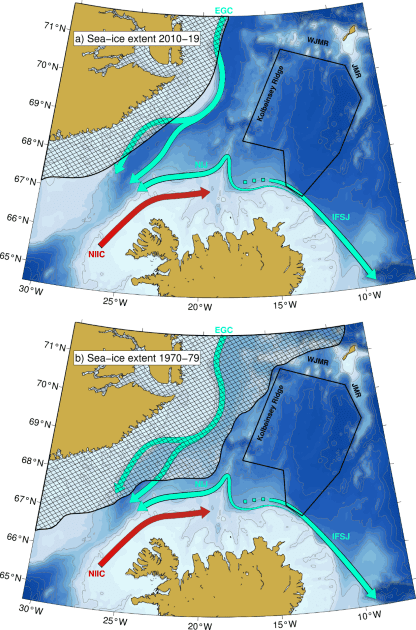Water mass transformation in the Iceland Sea: Contrasting two winters separated by four decades
Våge, K., Semper, S., Valdimarsson, H., Jónsson, S., Pickart, R., & Moore, G., 2022. Water mass transformation in the Iceland Sea: Contrasting two winters separated by four decades. Deep Sea Research Part I Oceanographic Research Papers, 186, 103824. https://doi.org/10.1016/j.dsr.2022.103824

Decadal change in sea-ice extent over the Iceland Sea. The hatched areas represent mean February–April ERA5 sea-ice concentrations in excess of 50% for the periods 2010–19 (a) and 1970–79 (b). The black polygon outlines the central Iceland Sea. The acronyms of the currents are: EGC = East Greenland Current; NIJ = North Icelandic Jet; IFSJ = Iceland–Faroe Slope Jet; NIIC = North Icelandic Irminger Current. Figure provided by Kjetil Våge.
How has dense-water formation in the Iceland Sea changed from the mid-1970s to the mid-2010s and what are the impacts on the overturning in the Nordic Seas? We used recent hydrographic data from gliders to quantify water mass transformation in the Iceland Sea and contrasted the present conditions with measurements from shipboard hydrographic surveys conducted four decades earlier. The data demonstrated that the depth of convection has remained largely unchanged, but the dense waters formed in the Iceland Sea have become warmer and less dense. Loss of sea ice in the western Iceland Sea has played an important role in modifying where and how the densest waters are formed, as well as regulating the role and importance of the Iceland Sea as a source of dense water to the overflows from the Nordic Seas.
